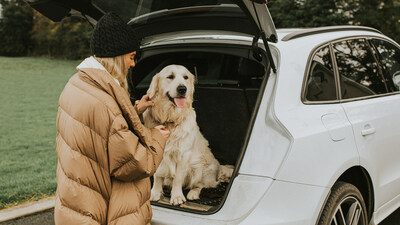Should Distracted Driving Laws Apply to Your Dog? Erie Insurance Survey Shows Americans Equally Divided on the Issue
New survey additionally reveals why so many Americans are driving with their dogs.
ERIE, Pa. , April 1, 2024 /PRNewswire/ -- Laws restricting cell phone usage to prevent distracted driving are becoming more commonplace. But what about legislation designed to address another common distraction in your car—your cute fluffy dog? That was the focus of a recent survey commissioned by Erie Insurance and conducted online by The Harris Poll, which documented that a vast majority of dog owners with a driver's license (92%) take their dogs in the car with them.
It's true. All that barking and jumping can be distracting. And if that distraction causes an accident, the consequences could be serious. According to the advocacy group Bark Buckle UP®, an unrestrained 60-pound dog can turn into a 2700-pound projectile in a 35-mph car crash when you apply mechanical force calculations.
But does that mean we need laws requiring our pups to be restrained, much in the same way that humans are required to wear seat belts? Some states seem to think so, which could soon make a loose dog in your car illegal. Although the reality is that only a few states have passed legislation that specifically mandates dog restraints (Rhode Island, Hawaii and New Jersey), more states are starting to apply general distracted driving standards to situations with unrestrained dogs and citing drivers whose dog's behavior is considered disruptive.
Needless to say, such action is not going over well with all dog owners. The Erie Insurance survey demonstrated that American dog owners with a driver's license who drive with their dog in the car are split right down the middle (50%) as to whether or not they think there should be laws mandating that dogs be restrained while in a moving vehicle.
Is an unrestrained dog truly a distraction?
In the same survey, 50% of dog owners with a driver's license who drive with their dog in the car believe their dog could cause an accident while in the car with them. Just how much are our dogs distracting us? According to a study conducted by Volvo in 2019, drivers with unrestrained dogs were distracted more than 10% of the total driving time. Over a total period of 30 hours, owners who had loose dogs took their eyes off the road for an average of three and a half hours. Meanwhile, owners with restrained dogs were only distracted for 1.39 hours, less than half the time.
Part of the reason for the distraction is where the dogs are located in the car. According to the Erie Insurance survey, the majority of dogs (69%) sit in the back seat when they're in the car.
However, a whopping 41% of dog owners with a driver's license who drive with their dog in the car put their dogs in the front passenger seat, even though the risk of injury from airbags or flying through the windshield is significantly higher there.
Perhaps even more troubling is the fact that of dog owners with a driver's license who drive with their dogs, 13% drive with their dogs on their laps.
Dogs can also be distracting because of humans' desire to keep them entertained. In the Erie Insurance survey, 83% of dog owners with a driver's license who drive with their dog in the car admitted to "entertaining" their dogs on a long road trip. Men were the bigger culprits in this area, with 88% of them claiming to entertain their dogs on long road trips compared to 77% of women.
The specific type of entertainment varied, with 45% letting their canine friends participate in the pastime of hanging their heads out the window. This can be distracting if you have to keep worrying about them jumping out or stepping on the button and inadvertently adjusting the window height. Nine percent let their dogs watch something on their phones. Again, men do this more often with 11% of men admitting they rely on this tactic vs. 6% of women.
How to make your dog less distracting?
Erie Insurance didn't undertake this research in order to separate humans from their beloved pets. Rather, Erie Insurance wants to spotlight a potential safety risk this Distracted Driving Awareness Month by providing tips for a safer, more relaxing ride with your pup.
There are essentially three ways for ensuring your dog is not a distraction while on the road with you:
- Bring a passenger with you who is responsible for calming, controlling and restraining your dog.
- Use any number of approved, specially designed dog restraint solutions, including harnesses, dog crates/carriers, dog car seats or hammocks. Or, if necessary for a long road trip, you might also request medication from your vet to help sedate your dog.
- Train your dog to become a less distracting, better-behaved passenger.
Paul Owens, "The Original Dog Whisperer" and a renowned dog trainer for 50 years, offers practical advice to help calm dogs before traveling in the car. Dogs typically express their stress in one (or more) or four ways: bark or whimper; pace or jump; pee, poop or vomit; or chew. To limit these distracting behaviors, Owens suggests the following:
- Get the energy out. Give your pup the chance to exercise and explore new smells on a walk to burn off some car excitement.
- Minimize risk. If you know your dog is likely to mess in the car, don't feed it for several hours prior to a ride.
- Boost confidence with gradual conditioning/desensitizing. Don't think you can just throw a harness around your dog. Rather, you will need to gradually get them used to it. Start by placing it near them and slowly get closer until they're willing to step through it on their own.
- Reward, reward and reward! Be sure to reward your dog with a favorite treat after each successful excursion or positive action. Always keep training sessions short—30 seconds to a few minutes—before giving a reward. And do so with a smile, as dogs can pick up positive vibes from you.
- Consider purchasing a ThunderShirt. These specially designed shirts apply constant and even pressure to help minimize anxiety.
- Be patient. Remember that dogs typically don't reach emotional maturity until 1-3 years. Depending on your dog's maturity level and prior experience with car rides, it could take 2-12 months to turn around a negative behavior and/or emotional response.
- Bring in a professional. If you're still not getting results on your own, it's time to call in a force-free, reward-based professional dog trainer. The right trainer with the right approach can turn your furry friend into a road trip champ.
For additional tips, you can order Owens' latest book, Training for the Joy of Dogs: Fifty Lessons Learned, which is available on Amazon.
Most importantly, Owens believes all dogs should be properly restrained in the car with a crash-tested harness that keeps them from accessing the window or the driver—not because a law requires it, but because it's the best way to keep your dog safe and able to enjoy many more rides with you in the future.
About Erie Insurance
According to A.M. Best Company, Erie Insurance Group, based in Erie, Pennsylvania, is the 12th largest homeowners insurer, 12th largest automobile insurer and 13th largest commercial lines insurer in the United States based on direct premiums written. Founded in 1925, Erie Insurance is a Fortune 500 company and the 19th largest property/casualty insurer in the United States based on total lines net premium written. Rated A+ (Superior) by A.M. Best, ERIE has more than 6 million policies in force and operates in 12 states and the District of Columbia. News releases and more information are available on ERIE's website at www.erieinsurance.com.
Survey Method:
This survey was conducted online within the United States by The Harris Poll on behalf of Erie Insurance from February 20 - 22, 2024 among 951 adults ages 18 and older who own a dog and are licensed drivers. The sampling precision of Harris online polls is measured by using a Bayesian credible interval. For this study, the sample data is accurate to within +/- 3.8 percentage points using a 95% confidence level.
For complete survey methodology, including weighting variables and subgroup sample sizes, please contact Jennifer.Sonntag@ErieInsurance.com.
![]() View original content to download multimedia:https://www.prnewswire.com/news-releases/should-distracted-driving-laws-apply-to-your-dog-erie-insurance-survey-shows-americans-equally-divided-on-the-issue-302104610.html
View original content to download multimedia:https://www.prnewswire.com/news-releases/should-distracted-driving-laws-apply-to-your-dog-erie-insurance-survey-shows-americans-equally-divided-on-the-issue-302104610.html
SOURCE Erie Indemnity Company



